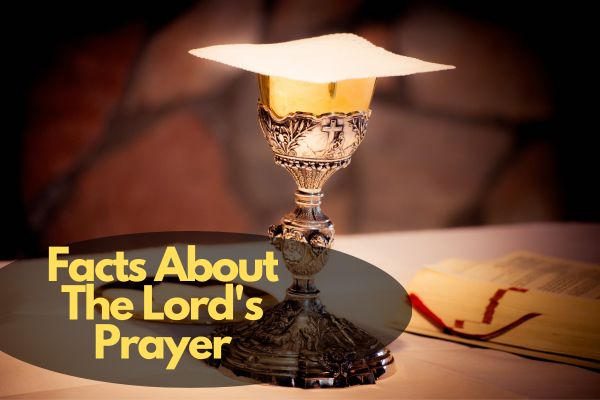Table of Contents Show
The Lord’s prayer represents an essential aspect of Christian spirituality and is recited by millions worldwide. Its profound meaning and historical significance have contributed to its enduring relevance in contemporary religious practices.
Facts About The Lord’s Prayer
The Lord’s Prayer is one of the most recognizable and cherished prayers in Christianity, revered for its simplicity and profound spiritual significance. Its words have echoed through the centuries, shaping the lives of believers and influencing various aspects of culture and tradition. Understanding the facts surrounding the Lord’s Prayer not only provides insight into its historical roots but also sheds light on its enduring impact on contemporary society.
Origins and History
Tracing the origins of the Lord’s Prayer leads us back to the teachings of Jesus Christ, who imparted it to his disciples as a model prayer during the Sermon on the Mount. Its roots lie in the Jewish tradition of prayer, incorporating elements of praise, supplication, and acknowledgment of God’s sovereignty. Over the centuries, the Lord’s Prayer has been a cornerstone of Christian spirituality, passed down through generations as a sacred and unifying text.
Significance in Christianity
The Lord’s Prayer embodies essential Christian beliefs, emphasizing the themes of reverence for God, spiritual dependence, forgiveness, and the coming of the Kingdom of God. It serves as a unifying force, transcending denominational boundaries and fostering a sense of communal worship among diverse Christian communities worldwide.
The Structure and Meaning of the Lord’s Prayer
Comprising seven petitions, the Lord’s Prayer presents a structured framework for addressing God, covering both spiritual and material needs. Each petition holds profound theological significance, emphasizing the themes of divine reverence, reliance on God’s providence, forgiveness, and deliverance from evil.
Interpretations Across Different Christian Denominations
Despite its universal appeal, the Lord’s Prayer has been subject to diverse interpretations within different Christian denominations. The varying theological perspectives have led to nuanced understandings of the prayer’s theological implications, resulting in rich theological debates and discussions within the broader Christian community.
The Lord’s Prayer in Liturgy and Worship
Within the context of Christian worship, the Lord’s Prayer holds a significant place in liturgical practices. Its recitation during church services, ceremonies, and private devotions serves as a spiritual anchor, fostering a collective sense of devotion and unity among worshippers. The centrality of the Lord’s Prayer in Christian worship services underscores its significance as a communal expression of faith and a unifying element within religious congregations.
The Lord’s Prayer in Contemporary Culture
Despite its ancient origins, the Lord’s Prayer remains relevant in contemporary religious discourse, serving as a guiding light for believers seeking spiritual solace and moral guidance.
The pervasive influence of the Lord’s Prayer extends beyond the realms of religious practice, permeating various facets of contemporary culture. Its echoes can be found in literature, music, art, and popular culture, serving as a source of inspiration for creative expressions and cultural representations.
Common Misconceptions and Debunking Myths
Despite its widespread recognition, the Lord’s Prayer has been surrounded by several misconceptions and myths. Addressing these misunderstandings and providing historical context is essential to ensure a comprehensive understanding of the prayer’s true essence and significance within the Christian tradition.
The Lord’s Prayer in Art and Literature
Throughout history, the Lord’s Prayer has inspired numerous works of art and literature, serving as a muse for artists, writers, and musicians. Its profound spiritual themes and timeless message have been translated into various artistic expressions, fostering a rich cultural legacy that transcends religious boundaries.
Personal Significance and Interpretation
For individual believers, the Lord’s Prayer holds personal significance, serving as a source of comfort, guidance, and spiritual solace. Its adaptable and inclusive language allows for personal interpretation, enabling individuals to establish a profound and intimate connection with God through prayer.
Modern Adaptations and Variations
In contemporary times, the Lord’s Prayer has undergone various adaptations and interpretations to cater to the evolving needs of diverse Christian communities. These adaptations reflect the dynamic nature of spirituality and demonstrate the prayer’s relevance in addressing modern concerns and aspirations.
The Lord’s Prayer in Different Languages
The linguistic adaptations of the Lord’s Prayer in diverse languages reflect the efforts to maintain its theological essence while accommodating the nuances and cultural contexts of different communities.
The universal appeal of the Lord’s Prayer is evident in its translation into numerous languages, allowing individuals from diverse linguistic backgrounds to engage with its spiritual message. The linguistic adaptations highlight the prayer’s global significance and its ability to foster a sense of unity among believers across cultural and linguistic boundaries.
Controversies Surrounding the Lord’s Prayer
Despite its widespread acceptance, the Lord’s Prayer has been a subject of controversy and debate within theological circles. These controversies have revolved around interpretations, theological implications, and contextual understandings, stimulating critical discourse and theological reflection within the Christian community.
The Lord’s Prayer in the Digital Age
In the digital age, the Lord’s Prayer has found new avenues for dissemination and engagement through various online platforms and digital resources. Its accessibility in digital formats has facilitated its widespread reach, enabling individuals to engage with the prayer’s spiritual message and theological significance more conveniently.
Conclusion
The Lord’s Prayer remains a timeless testament to the enduring power of faith, serving as a cornerstone of Christian spirituality and a symbol of unity among believers worldwide. Its profound theological significance, cultural influence, and personal resonance continue to enrich the lives of individuals and communities, fostering a deep sense of spiritual connection and devotion.
FAQs
- What are the main themes of the Lord’s Prayer? The main themes of the Lord’s Prayer include reverence for God, spiritual dependence, forgiveness, and the coming of the Kingdom of God.
- How is the Lord’s Prayer recited in different Christian denominations? The recitation of the Lord’s Prayer can vary slightly among different Christian denominations, reflecting nuanced theological perspectives and liturgical practices.
- What is the significance of the Lord’s Prayer in contemporary culture? The Lord’s Prayer has influenced various aspects of contemporary culture, including art, literature, music, and popular culture, serving as a source of inspiration for creative expressions and cultural representations.







